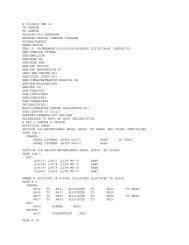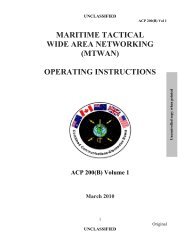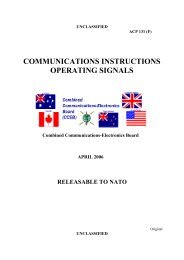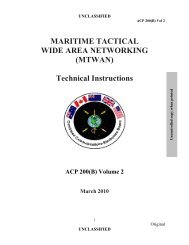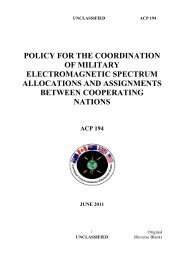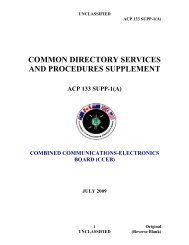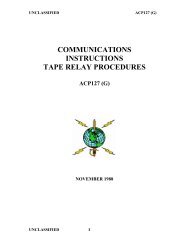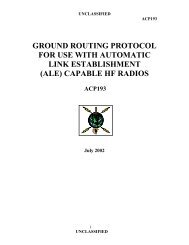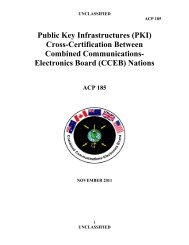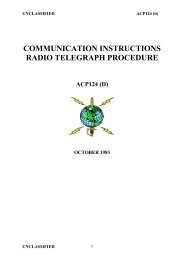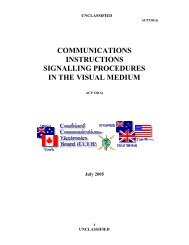ACP 201
ACP 201
ACP 201
You also want an ePaper? Increase the reach of your titles
YUMPU automatically turns print PDFs into web optimized ePapers that Google loves.
Uncontrolled Copy When Printed<br />
UNCLASSIFIED<br />
ANNEX C TO<br />
CHAPTER 2 TO<br />
<strong>ACP</strong> <strong>201</strong><br />
E-MAIL ETIQUETTE<br />
1. Although most people give careful thought to what is written down on paper, most e-<br />
mails are composed with much less consideration. Off hand remarks and unguarded<br />
comments, thoughtless turns of phrase and careless wording can easily create offence or<br />
confusion. This miscommunication can be time consuming, costly and in extremis,<br />
hazardous in the military environment. Care must be taken when both composing and<br />
interpreting e-mail. Irony or humor can be difficult to express in an e-mail message.<br />
2. The following are commercial best practices for the efficient use of staff time and e-<br />
mail resources, understanding that recipients of e-mails will be more likely to read and reply<br />
to e-mails that can be easily and quickly understood and prioritized:<br />
a. Limit each e-mail message to one topic, briefly stating the purpose of the e-<br />
mail in the beginning of the e-mail text;<br />
b. Give careful consideration in composing an e-mail, as the meaning and tone<br />
that is intended at the writing stage may not be the same as that inferred by the<br />
recipient, particularly in the absence of body language. Use of all capital letters or all<br />
bold font in e-mail text may be considered shouting and should be avoided;<br />
c. Write in a concise, professional and ethical manner, as private thoughts may<br />
be construed as being representative of the attitudes of your Command or even your<br />
Government;<br />
d. On shared networks, avoid data transfer and duplication of file storage by<br />
using a hyperlink, the directory location, a short-cut or web address within the e-mail<br />
for the recipient to access;<br />
e. Send e-mails or replies to only those who need to know. Avoid the use the<br />
‗reply all‘ unless all addressees actually need to know;<br />
f. If possible, check the properties of group addressees to ensure all persons<br />
listed in the group actually need to receive the e-mail;<br />
g. Always read through the e-mail from the perspective of the addressees to<br />
ensure it is sensible, without ambiguity and that it clearly portrays your intent;<br />
h. Think before forwarding someone‘s e-mail attached (with history) to your e-<br />
mail, to ensure it will not cause any damage or embarrassment to the originator;<br />
i. If revising or adding to an existing e-mail document, precede the revisions<br />
with the author‘s initials and put comments in a different color so they are obvious to<br />
the recipient;<br />
2C-1 Original<br />
UNCLASSIFIED<br />
(Reverse Blank)



